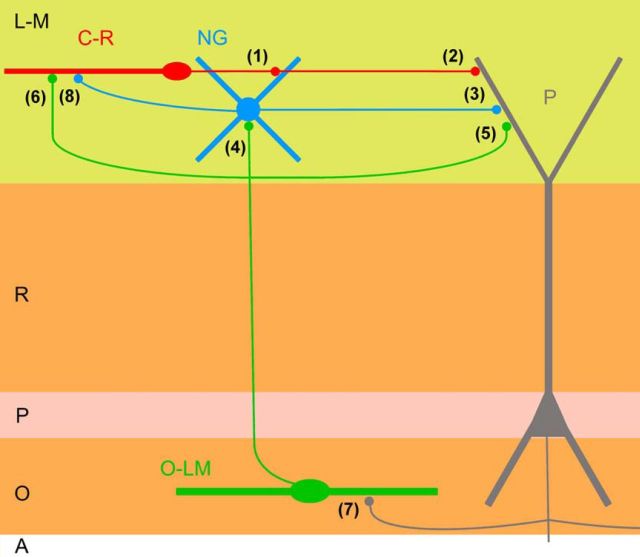Figure 14.
Cajal-Retzius cells within the hippocampal circuit. We identified Cajal-Retzius cells (C-R) as a novel source of glutamatergic inputs for neurogliaform cells (NG; synapse indicated by 1) and pyramidal cells (P; synapse indicated by 2; but notice that the possibility that different types of Cajal-Retzius cells target either interneurons or pyramidal cells cannot be excluded; also, please see Discussion for the possibility of spillover). In addition, Cajal-Retzius cells, through the modulation of the interneurons activity, are able to drive a powerful disynaptic inhibition on pyramidal cells (synapse 3; for a review of the neurogliaform-pyramidal cells connection, see Capogna and Pearce, 2011). Data in the literature show that neurogliaform cells activity can be modulated by inputs from O-LM cells (synapse 4; Elfant et al., 2008), which also provides GABAergic inhibitory inputs to pyramidal cells (synapse indicated by 5; Maccaferri et al., 2000) and GABAergic excitatory inputs to Cajal-Retzius cells (synapse indicated by 6; Quattrocolo and Maccaferri, 2013). O-LM cells create a feedback inhibitory loop with pyramidal cells, which are their main source of excitatory inputs (synapse indicated by 7; Ali and Thomson, 1998; Losonczy et al., 2002). The activity of Cajal-Retzius cells can also be modulated by GABAergic inputs from neurogliaform cells (synapse indicated by 8; Quattrocolo and Maccaferri, 2013), whose final effect depends on the level of polarization of the membrane of Cajal-Retzius cells. L-M, stratum lacunosum-moleculare; R, Stratum radiatum; P, stratum pyramidale; O, stratum oriens; A, alveus.

